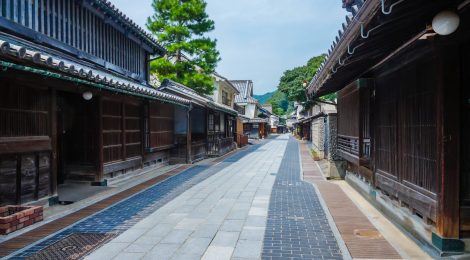
Takehara
Takehara, also known as the little Kyoto of Hiroshima, is a town that offers a unique glimpse into japan‘s rich history and culture. Located in Hiroshima Prefecture, Takehara was once a thriving center for salt and sake production. Today, it is renowned for its preserved historical townscape, featuring traditional wooden buildings that date back to the Edo period.
One of the highlights of Takehara is its main streetway, which is lined with these traditional wooden buildings. Walking along this street feels like stepping back in time, as you admire the intricate architecture and craftsmanship of the Edo period. The town is often referred to as the “town facing the Seto Inland Sea,” adding to its picturesque charm.
One of the most striking features of Takehara’s wooden buildings is the “Takehara Lattice.” This intricate lattice design adorns many of the traditional buildings and is reminiscent of paper art. The lattice adds a sense of elegance and beauty to the town’s architecture, making it a must-see for visitors.
For those interested in traditional crafts, a visit to the Machinami Bamboo Studio is highly recommended. Here, you can experience the art of bamboo craft-making firsthand. The studio offers workshops where you can learn various techniques and create your own bamboo crafts. It’s a great way to immerse yourself in the local culture and take home a unique souvenir.
No visit to Takehara would be complete without tasting its famous sake. While the town has ceded its sake making crown to the nearby sake district of Saijo, there is still one sake brewery located within the historically preserved area. The Fujii Shuzo Sake and Souvenir Store is a must-visit for sake lovers. Here, you can taste a variety of sake brewed using traditional methods and locally grown rice. The brewery takes pride in its award-winning brews and continues to uphold the legacy of sake brewing in the region.
Interestingly, Takehara has a connection to the history of Japanese alcohol beyond sake. Masataka Taketsuru, the founder of Nikka whisky, was born in Takehara in 1894. After leaving his family’s sake brewery, Taketsuru traveled to Scotland, where he learned the art of whisky making. He then returned to Japan and founded the Nikka whisky company. Today, whisky enthusiasts can visit Takehara to learn more about Taketsuru’s roots and the influence he had on the Japanese whisky industry.
Takehara is not only a town of historical significance but also a place of vibrant festivals. Throughout the year, several colorful festivals take place in the town, showcasing the local traditions and culture. One of the most renowned events is the “Takehara Longing Road,” which illuminates the town’s historic district with the light of 5,000 bamboo lanterns. This mesmerizing spectacle attracts more than 30,000 visitors each year.
Another festival that shouldn’t be missed is the Sumiyoshi Festival, which takes place during Obon, a Buddhist event for commemorating ancestors. During the festival, women dressed in traditional kimono dance through the streets of Takehara, creating a beautiful sight. Lit paper lanterns are also floated on the bay, adding to the magical ambiance of the event.
If you’re looking for relaxation and rejuvenation, Takehara has natural hot springs nearby. One notable spot is Enmei no Yu at Kamogawaso. This hot spring offers a tranquil setting where you can soak in the healing waters and enjoy the surrounding nature. Yusaka Onsenkyo is another popular area for tourists, featuring a Japanese garden and a variety of hot spring facilities.
For those who enjoy hiking and breathtaking views, a visit to Mt. Kurotaki is a must. Located just one train stop east of Takehara Station, Mt. Kurotaki stands at 266 meters tall and offers a panoramic view of the city and the Seto Inland Sea. The hike to the summit takes around 45 minutes and is adorned with thirty-three Buddhist stone statues, which were donated by the locals over 150 years ago. These statues serve as guardians, watching over hikers as they make their way up the mountain.
To reach Takehara, the best option is to take a train from Hiroshima. From Tokyo or Osaka, you can travel to Hiroshima via bullet train and then transfer to a local train or bus to reach Takehara. If you prefer traveling by bus, there are direct highway buses that run from Hiroshimaeki Bus Stop at the train station to Takehara Station. The journey takes approximately one hour and ten minutes.
Once you arrive at Takehara Station, the preserved townscape area is just a twelve-minute walk away. As you explore the town, you’ll be captivated by its timeless beauty and the warmth of its residents. Takehara offers a unique experience that allows you to step back in time and immerse yourself in the rich history and culture of Japan.
In conclusion, Takehara is a hidden gem in Hiroshima Prefecture, offering a glimpse into Japan’s past. With its preserved historical townscape, traditional wooden buildings, and vibrant festivals, Takehara is a town that shouldn’t be missed. Whether you’re interested in history, traditional crafts, sake tasting, or simply enjoying the beauty of nature, Takehara has something to offer. So take a stroll back in time and discover the charm and elegance of Hiroshima’s little Kyoto.
Address And Maps Location:
Takehara-shi, Hiroshima-ken
Subscribe, follow @idbcpr and idbackpacker.com